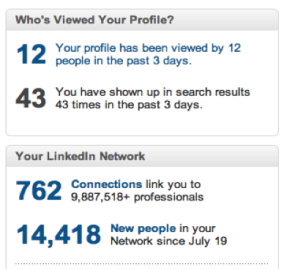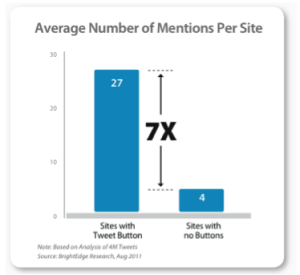How To Attribute Comparable Value To Search & Social Campaigns
The rapid growth of social media has meant that search engines now invest a significant amount of time into innovating how content discovery works on the Web. Recent projects such as Facebook Graph Search and the growth and adoption of Google+ signify the developing relationship between search engines and social media platforms. Search engines are increasingly using […]
The rapid growth of social media has meant that search engines now invest a significant amount of time into innovating how content discovery works on the Web. Recent projects such as Facebook Graph Search and the growth and adoption of Google+ signify the developing relationship between search engines and social media platforms.
Search engines are increasingly using social media activity such as Likes, Tweets, Shares, and +1s to determine which pages are most relevant for keyword searches and to provide a personalized search experience. Meanwhile, social networks are rapidly developing their search capabilities to surface real-time information and interest demographics.
Social media has changed the way we work, and marketers are realizing that its importance and influence need to be correlated with ROI. Two of the biggest changes I have witnessed over recent years are:
- Social media development and innovation has caused marketers look for new ways to measure and optimize search and social media campaigns, and
- Search and social media growth has led to a convergence of campaign messaging across the two channels and an interplay of metrics.
In my last article, I talked about the intrinsic nature of the relationship between search and social, the convergence of content marketing, and the growth of mobile search.
Today, I would like to highlight key social media metrics that not only form the foundation of any search campaign, but also help you to attribute comparable value to your social campaigns.
After all, positive actions and behavior that encourages sharing of content across search and social channels should lead to a positive outcome — such as increased ROI.
As Channels Merge, Metrics Merge
As illustrated in the diagram below, online marketers inhabit a fragmented and complex social media ecosystem with a number of tools, platforms, and networks that fill the landscape between the marketer and the consumer.

Image used with permission: LUMA Partners
It is essential that while you navigate this landscape, you keep your focus on primary metrics that drive ROI. However, choosing the right metrics to measure and understanding the impact between social, search and other media channels can be difficult — with so many social media platforms, each with their own analytics, optimization and management needs, it’s easy to feel distracted or overwhelmed.
Social Media Metrics That Influence ROI
In social, just like with search, there are ways to estimate the potential ROI of a campaign. In this section, we will touch upon examples of data points from different social networks that illustrate how you can ultimately understand and better estimate your potential ROI from social.
1. Size & Reach
When you build a search campaign, the first thing you do is calculate the size and reach of your campaign. Social is no different, and the most obvious place to start is by calculating and aggregating the number of followers on Facebook, Linkedin, Twitter and Google+, plus the number of subscribers to email and Blog RSS feeds.


On both Twitter and Facebook, for example, you can measure the number of followers and friends, updates, update recency, and follower/following ratio. But, rather than have these as standalone social metrics, you can think of them as comparable reach metrics for search ads.
If the number of keywords you can think of and authentically target is a measure of reach on search engines, then similarly, every follower or Like you earn effectively expands the reach of your social campaigns. The equation is simple — the more Likes and followers you have, the more users you can target ads to within social networks.
Social influence scores like Klout or social analytics services like Topsy can then help you get an idea of who the best users are to work with to expand your network of likers and followers.
Whatever you measure on any of these platforms, the priority here is to determine how you can measure social media’s impact on the metrics that are already in place to monitor the value drivers in your business. How does your social reach stack up against the reach of your search campaign?
To compare, use metrics you are already familiar with such as reach, activation or conversion, brand influencers, purchase, rank, conversion and ROI. By working with the language your company, or your client, is already familiar with and using internally, you can help bring them into the discussion of measuring ROI rather than confusing them with too many different data points.
2. Amplification & Engagement
Google has raised the bar in ensuring that only relevant, quality content that users read is recognized in SERPS. For social media marketers, it is more important than ever to understand what content will resonate with your audience, and measuring engagement as a result of content allows you to identify “gold” content.
This content can then be optimized so that search, social and content strategies can be built around it. Remember, social sharing and content are tied together very closely.
Develop a system to keep track of your content, such as:
- Creating tags to measure your content and amplification based on social media channels such as Tweets, Likes, +1’s and RT’s.
- Measuring and tracking cross-channel social media metrics – Tweet to your Facebook page and so forth so you can determine what type of content/message works on each different channel and build strategies accordingly.
- Analyze traffic and site behavior of visitors to shared pages.
- Capture engagement metrics relative to traffic, such as interactions per referred visit.
For example, on YouTube, while the total number of channel subscribers gives an idea of the overall popularity of the content, the per-video analytics often contain more valuable data for determining genuine engagement. The number of people that watched the video can be segmented by region and demographics. You can also find out how users discovered your content — such as via Google search or YouTube search — and see whether you have similar or different types of keyword queries in the two search engines.
If you are running ads on YouTube, it is worth measuring where users drop out of watching your videos; the more full plays your ads get, the higher the total play count is on your channel, which will have a positive impact on the ranking of any subsequent content you upload.
Likewise, on your blog, the total number of RSS and email subscribers gives you an idea of potential reach, but the number that actually read a particular blog post related to a promotion is a more accurate measure of impact. A useful exercise is to look at the wording of headlines in your most successful posts – do your readers respond more to offers, guides or news content?
3. Sentiment & Trends
Measuring sentiment is what many regard as a “soft” social media metric.
There are a hundreds of tools and services that do this, but the quality of analysis varies from service to service. Measuring brand sentiment and trust is not an exact science, but there are some things you can do to help quantify it.
Define and track negative, positive or neutral keyword phrases in social media posts. You can start by building out keyword lists to track what you perceive to be “positive” and “negative” keywords related to your brand.
Positive brand sentiment is normally indicated when website conversion rates increase with or without an increase in website traffic. Negative sentiment can be shown when a negative trend between traffic and conversion rates is identified. Also, if traffic remains consistent from social media and referral sources, but conversion rates continue to drop, this may show negative sentiment
Sentiment analysis is an important part of trend analysis, which means you are looking for signs of escalation as you prepare to take action, if needed. Track all positive and negative comments and spot trends to work out whether you should create ads or content addressing those particular trends.
4. Conversion & Economic Value
Although it is easier to measure the impact of a stand-alone social media project, such as a simple Tweet campaign measured against simple metrics, the best way to measure economic value is by looking at how your campaigns influence one another.
Measuring social media value based on its impact on other channels, such as search, is more complex — but a holistic view of the interplay between all the data points is increasingly achievable.
Not all social media activity may drive ROI directly, but can nonetheless drive an overall return on your investment in digital.
For example, key business functions such as R&D, client service and technical support derive value from social media by listening, while specific social activities are easily tied directly to earning KPIs. If investment and financial gain are relevant KPIs, this can turn into ROI.
Therefore, social media’s value is determined by its ability to influence specific outcomes. This could be the acquisition of a new customer, a new sale, recommendations and referrals. It could also be shown as a shift in sentiment between products and innovations, a boost in customer feedback and satisfaction or positive PR.
Measuring the impact of social media becomes less complex if you think of it as it as activity-specific. Measuring the value of social media depends on two things:
- Are you using social media to pursue a specific business objective associated with that channel? (e.g., more plays on YouTube, more followers on Twitter)
- Are you using social media to drive value and ROI via other channels?
For example, Leading digital marketing agency, Performics, and Feeding America combined information on Tweet volumes for specific topics with search engine rankings and web analytics data to determine what to Tweet about. They then matched their findings with their own most relevant website content to reference in new outbound Tweets to tap into the zeitgeist of sharing. By consistently Tweeting about trending topics where they already had great content, Feeding America achieved great results.
Conclusion
The increased importance of social signals means it is now essential to look at how, when, and why these signals influence rankings and position. Creating a Google+ page, adding social plugins, interlinking deep pages with social media properties and optimizing your social pages are all vital steps in tapping into the social Web while priming your brand for visibility in the social knowledge graph.
Measuring SEO KPIs such as links, rankings and search traffic in conjunction with social KPIs such as Likes, fans, friends, followers, network size and growth rate can give marketers a more holistic view of campaign success and ROI progress.
Opinions expressed in this article are those of the guest author and not necessarily Search Engine Land. Staff authors are listed here.
Related stories

